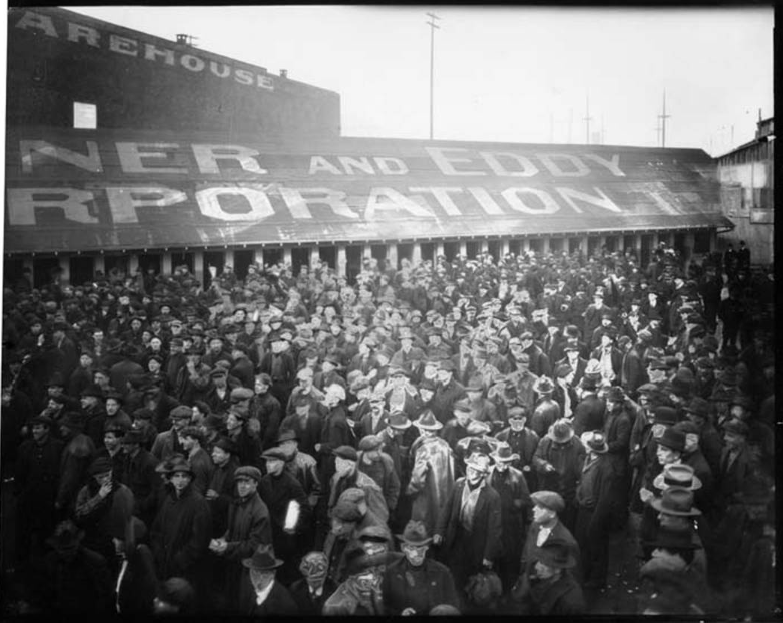Unity is Strength: The Seattle General Strike
Posted by Pete on Feb 8th 2021
102 years ago today, a strike went city-wide in Seattle and the workers cast the bosses aside to run the show themselves...
It was February 1919.
The Great War had just ended in Europe, but there was trouble brewing at home in the United States.
Times were hard for American workers, less so for their bosses. But the workers knew how to fight back.

The war years had seen unionization increase by 400% - the American labor movement was so much more powerful than today.
In the shipyards of Seattle, the unions demanded a raise for unskilled workers and two years of wartime wage controls. Trying to divide and rule, the bosses came back with a raise for skilled workers only.
It didn’t work.
On 21st January 1919, the unions brought 35,000 shipyard workers out on strike.
Seattle was bubbling with solidarity for its longshoremen, when, 102 years ago today, the strike went city-wide. Over 65,000 workers across the Seattle economy were out – it was the Seattle General Strike.

But this wasn’t just a work stoppage. To spare the people of Seattle disruption, the General Strike Committee effectively took over the running of the city. This was workers’ control.
While the Seattle bosses’ coffers went unfilled, the strikers provided essential public services like garbage collection and laundry work for the hospitals.
Firemen were provided exemption from the Strike, and a group of WWI veterans formed a non-coercive Labor War Veteran’s Guard to provide public order.
On a blackboard at their HQ was written,
It worked.
In the midst of its General Strike, Seattle was remarkably peaceful and content under its de facto government of workers. An army commander sent to inspect the state of Seattle told the Strike Committee that he’d never seen a city so quiet and orderly.
And that’s what scared the bosses so much. Not Seattle being shut down, but Seattle doing just fine without them.
As a wonderful poem in the city’s Union Record said:
“What scares them most is
That NOTHING HAPPENS!
They are ready
For DISTURBANCES.
They have machine guns
And soldiers,
But this SMILING SILENCE
Is uncanny.”
It went on,
“It is the garbage wagons
That go along the street
Marked “EXEMPT
By STRIKE COMMITTEE.”
It is the milk stations
That are getting better daily,
And the three hundred
WAR Veterans of Labor
Handling the crowds
WITHOUT GUNS,
For these things speak
Of a NEW POWER
And a NEW WORLD
That they do not feel
At HOME in.”
The poet couldn’t have been more accurate.
Terrified by the prospect of Seattle’s marvelous example being taken up by workers elsewhere in the US, the authorities prepared for war.
The Mayor mobilized thousands of new Police Deputies from among the city’s upper-classes and called in US Marines.
He threatened the utterly peaceful strikers with violence as the national news media went into a frenzy over the ‘Red’ uprising in the Pacific Northwest.
Under this sort of coercive pressure, and with the national labor union leaderships starting to waiver, the Seattle General Strike fizzled out on the 11th February.

In its aftermath, the authorities arrested 39 members of the Industrial Workers of the World (IWW) on the absurd charge of having been “ringleaders of anarchy” in Seattle.
These were the beginnings of the mortifying and despotic ‘Red Scare’ which followed the Great War.
It saw the mass, illegal deportation of left-wing activists like Emma Goldman with the Palmer Raids, the imprisonment of Socialist Party leader, Eugene Debs, and countless murders across the United States. An orgy of reactionary violence, instigated in large part by the White House and Congress, which, while painful to remember, is essential to never forget.
Moreover, the Seattle General Strike of February 1919 is a window into what drove American elites to conduct this Terror.
Not a threat to democracy or the American way of life, but the fear that if the American people were allowed to see that – as in Seattle – they could live without plutocracy, they might just want to.
